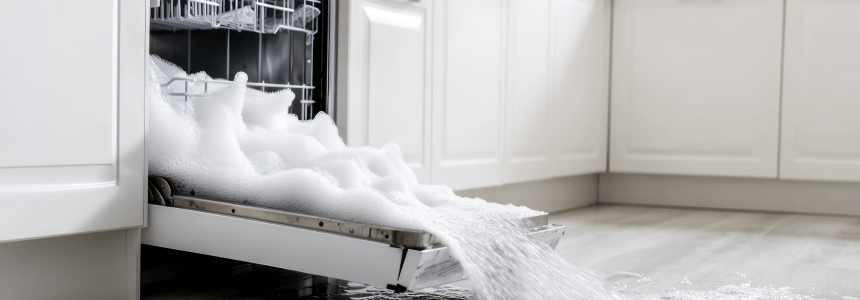
Contemplating coverage?
Subscribe to receive our emails & get
$200 OFF!
Have questions?
Call us: (833) 544-8273


Written By Angel Vallejo
There’s nothing more frustrating than opening your dishwasher and finding a pool of dirty water at the bottom. When your dishwasher won’t drain properly, it’s not just inconvenient—it can be a sign of a bigger issue. If you’ve found yourself in this situation and are wondering how to drain dishwasher water quickly and safely, rest assured that it’s a common dishwasher problem and this guide is here to help.
Fortunately, in many cases, the problem can be fixed without calling a technician. In this post, we’ll walk you through practical steps to manually drain your dishwasher and troubleshoot the most common causes of standing water.
Before diving into the draining process, it’s helpful to understand what might be causing the problem. Some of the most common reasons your dishwasher won’t drain include:
Knowing what you’re dealing with helps you not only drain the water but also fix the root cause so it doesn’t happen again.
There’s a reason Liberty Home Guard was rated the #1 Home Warranty
Service by U.S. News and World Report for 2021, 2022, 2023, and 2024. Check out our services.
If your dishwasher won’t drain on its own, follow these simple steps to safely remove the water and start investigating the issue.
Safety first! Unplug your dishwasher or turn off the circuit breaker to eliminate the risk of electrical shock. If your dishwasher is hardwired, locate the dedicated breaker in your electrical panel and switch it off.
Pull out the lower rack to access the standing water and filter. This gives you full visibility into the bottom of the tub and helps with cleanup.
There are two effective ways to drain the water manually:
Repeat until all visible water is removed.
Remove the filter (usually located at the bottom center) and rinse it under running water. Check the drain area for debris like food particles, glass, or plastic that might be blocking water flow.
Locate the dishwasher’s drain hose. It’s typically connected to either the garbage disposal or the sink drain. Look for any of the following:
If needed, detach the hose and flush it out with a mix of hot water and vinegar to remove any obstructions.
Some kitchen sinks have an air gap—usually a small fixture mounted near the faucet. If this gets clogged, it can prevent proper drainage. Unscrew the top, clean out any debris, and run water through the opening to ensure it’s clear.
Once you’ve removed the blockage and reassembled everything, restore power and run a short rinse cycle. Observe the drain process to confirm whether the issue is resolved.
If water continues to pool in the bottom, you may be dealing with a faulty drain pump or motor, which could require professional help.
To avoid dealing with standing water again, it’s helpful to know the most frequent culprits behind drainage issues.
To avoid future drainage problems, adopt these simple dishwasher maintenance habits:
Regular care helps extend the life of your appliance and ensures optimal performance.
While many drainage issues can be fixed at home, some situations require a trained technician:
In these cases, it’s best to call an appliance repair expert. Or, if you have a home warranty through Liberty Home Guard, file a claim for quick service.
A dishwasher that won’t drain doesn’t have to ruin your day or your dinner plans. With the right know-how and a few basic tools, you can safely remove standing water, diagnose the issue, and get your appliance running like new again. At Liberty Home Guard, we believe in empowering homeowners with knowledge and protection. Explore our home warranty plans that help you tackle the unexpected from appliances to plumbing and more. Please check out more of our brand-specific articles that address specific questions about why your GE, Maytag or Whirlpool dishwasher won’t drain.
There’s a reason Liberty Home Guard was rated the #1 Home Warranty Service by U.S. News and World Report for 2021, 2022, 2023, and 2024. Check out our services.
Learn MoreUnplug the dishwasher, remove the bottom rack, and scoop out standing water with a cup or soak it up with towels. Then clean the filter and check the drain hose for clogs.
Common causes include a clogged filter or drain hose, blocked air gap, kinks or disconnections in the hose, a faulty drain pump, or garbage disposal connection issues.
Clean the filter weekly, run hot water before cycles, use dishwasher-safe cleaners monthly, avoid overloading racks, and scrape dishes before loading to reduce food buildup.
Call an appliance repair technician if the drain pump or motor is broken, the dishwasher makes unusual noises, water won’t drain after troubleshooting, or the unit trips the breaker.
Stay Ahead of Potential
Home Mishaps!
Subscribe to our Liberty Home Guard Newsletter and gain access to exclusive content that ensures your peace of mind.